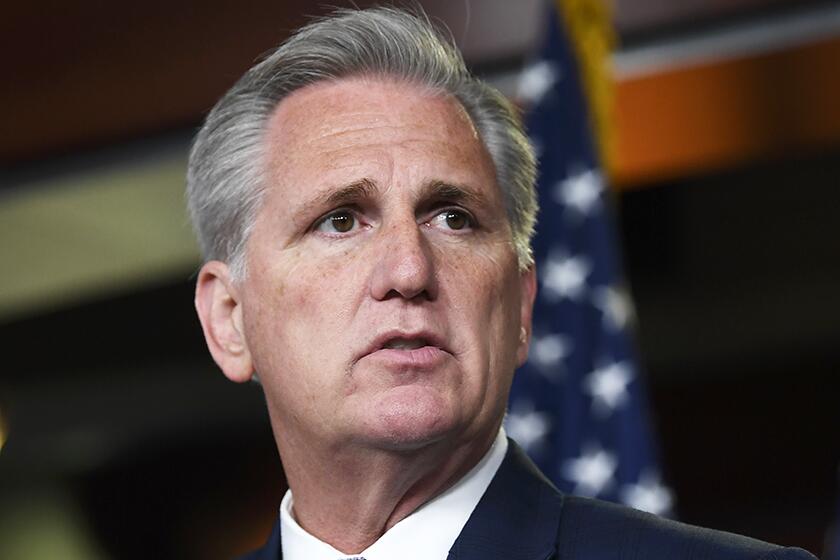COLUMN LEFT/ ALEXANDER COCKBURN : The President’s Pig-Out Manifesto : Bush knew his claims for a capital-gains tax cut were drivel.
The Republican strategy in this election year has been unveiled: class war. As expounded by President Bush in his State of the Union address, the agenda could not be more shameless. The rich get a big tax break and the rest get small change. If the country were populated entirely by people with incomes above $100,000 a year, the campaign would be over.
Set against the economic realities of 1992, there is something awe-inspiring about the purblind inequity of the President’s proposals. Amid the economic rubble of the Reagan-Bush years, three features stand out: the speculative mania that has almost destroyed the financial system; the speculative building boom that has led to record vacancy rates in commercial real estate and imperiled the banks and insurance companies financing such activity, and the regulatory surrender that permitted such rampages.
The same three features constitute the drive-train of Bush’s economic agenda. Bush’s proposed cuts in the capital-gains tax rates would reward all the vices of the Roaring ‘80s. To a nation still stricken with the consequences of the last building boom, he promises new breaks for real-estate speculators. And he announces a new war on regulation.
The centerpiece of the Bush program is the drive to lower the tax rates on capital gains. In his address, Bush had the effrontery to claim that this would be a boon for the little guy and that any benefit to the rich would come almost as an unintended side effect.
This is pure nonsense, as even Bush’s Treasury officials admit. A cut in the capital-gains tax benefits those with capital. Less than 10% of those with incomes under $50,000 have any capital gains, as opposed to more than half of those with incomes above $200,000.
Of course, Bush and his associates do not care to have it put so baldly, that the simple purpose of their proposed capital-gains tax cut is to give the rich another break. They like to argue that the scheme has a loftier purpose: that the consequent surge in business activity will lead to the sort of growth associated with a huge drop in interest rates.
Let us consider in this light an extraordinary exchange that took place in Congress almost exactly two years ago. The exchange, between Michael Boskin, chairman of the Council of Economic Advisers, and Sen. Paul Sarbanes (D-Md.), makes it clear that the White House has known all along that the lofty claims for the capital-gains cut had no basis in fact, and that it would merely be doing the rich a favor.
Sarbanes asks Boskin if, as the White House claims, the proposal is designed to lower interest rates (what economists call “the cost of capital”). Here’s the exchange, as it took place on Jan. 24, 1990, before the Joint Economic Committee:
Sarbanes: “ . . . the main point of the capital gains tax cut is to reduce the cost of capital. Is that correct? Do you subscribe to that point of view?”
Boskin: “Yes. We have talked about it many times, yes.”
Sarbanes: “How much would interest rates have to fall to give the same reduction (in) the cost of capital as a 30% capital-gains exclusion?”
Boskin: “A small amount.”
Sarbanes: “Am I correct that it would have to fall only 5/100 of 1%?
Boskin: “I was about to say probably 10 basis points, or something like that, 15.”
A basis point is one 1/100 of 1%. Jeff Faux, president of the Washington-based Economic Policy Institute, who exhumes this amazing confession in the latest issue of the magazine Challenge, points out that even with Boskin’s optimistic assumptions, the Administration’s tax-cut proposal at that time would have had an effect on investment equivalent to a drop in interest rates from 7% to 6.85%
In his latest version, Bush wants to drop the rate as much as 50%, which would be the equivalent--on Boskin’s computation--of an interest drop of .5%. To put this in perspective, the drop in the prime rate offered by commercial banks between October, 1990, and October, 1991, amounted to almost 2.5% (from 7.81% to 5.34%) It still wasn’t enough to crank up investment and turn the recession around.
So when Bush told Congress the other night that a cut in the capital-gains tax “increases jobs and helps just about everybody in our country” he was talking drivel.
So much for the Bush program: more speculation, more wealth transferred to the rich--and somewhere soon down the road, a taxpayer bailout of the Federal Deposit Insurance Corp. At least the agenda has a certain clarity. The rich are to get richer and the rest get deregulation, meaning a dirtier environment, a more dangerous workplace and, in the end, the taxpayers will have the privilege of paying for the pig-out at the top of the pyramid.
More to Read
Get the L.A. Times Politics newsletter
Deeply reported insights into legislation, politics and policy from Sacramento, Washington and beyond. In your inbox three times per week.
You may occasionally receive promotional content from the Los Angeles Times.










